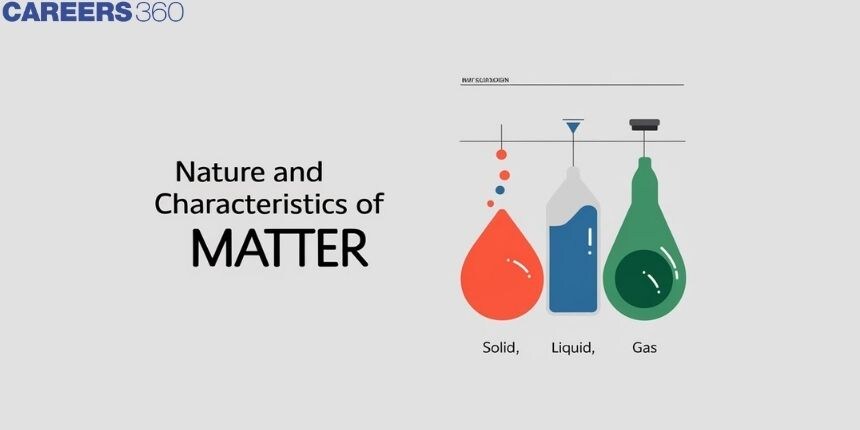Nature and Characteristics of Matter: What is, Examples, Particles
Chemistry is part of the science which embraces the investigation of the components of materials, their characteristics and the forms of their organization, the transformations that the given material passes through under the influence of certain circumstances, and the principles of such transformations. Chemistry is a core discipline of science and is related to other sciences on many occasions. Thus, it also has a significant role in our everyday life.
NEET 2025: Mock Test Series | Syllabus | High Scoring Topics | PYQs
JEE Main: Study Materials | High Scoring Topics | Preparation Guide
JEE Main: Syllabus | Sample Papers | Mock Tests | PYQs
- Importance of Chemistry And Nature of Matter
- Some Solved Examples
- Conclusion

Importance of Chemistry And Nature of Matter
Chemistry deals with the composition, structure, and properties of matter. These aspects can be best described and understood in terms of basic constituents of matter: atoms and molecules. That is why chemistry is called the science of atoms and molecules.
Chemistry plays a central role in science and is often intertwined with other branches of science like physics, biology, geology, etc. Chemistry also plays an important role in daily life. Chemical principles are important in diverse areas, such as weather patterns, the functioning of the brain, and the operation of a computer. Chemical industries manufacturing fertilizers, alkalis, acids, salts, dyes, polymers, drugs, soaps, detergents, metals, alloys, and other inorganic and organic chemicals, including new materials, contribute in a big way to the national economy. Chemistry plays an important role in meeting human needs for food, healthcare products, and other materials aimed at improving the quality of life.
Anything which has mass and occupies some space is called matter. Based on shape, size, and volume, the matter can be classified into solids. liquids and gases.
Solids have definite volume and definite shape.
Liquids have a definite volume but no definite shape. They take the shape of the container in which they are placed.
Gases have neither a definite volume nor a definite shape. They completely occupy the container in which they are placed.
These three states of matter are interconvertible by changing the conditions of temperature and pressure.
Solid $\underset{\text { cool }}{\stackrel{\text { heat }}{\rightleftharpoons}}$ liquid $\underset{\text { cool }}{\stackrel{\text { heat }}{\rightleftharpoons}}$ Gas
On heating, a solid usually changes to a liquid, and the liquid on further heating changes to the gaseous ( or vapour) state. In the reverse process, a gas on cooling liquifies to the liquid, and the liquid on further cooling freezes to the solid.
Recommended topic video on(Nature and Characteristics of Matter)
Some Solved Examples
Example 1: Which of the following is known as dry ice?
1) Gaseous CO2
2) Solid SiO2
3) CH4
4) Solid CO2
Solution
Solid CO2 is called as dry ice.
Hence, the answer is the option (4).
Example 2: Which of the following exists as a solid at room temperature?
1)Cl2
2)F2
3) I2
4) Br2
Solution
F2 and Cl2 are gases, Br2 is a liquid and I2 exists as a solid at room temperature because of the difference in intermolecular forces that act on between individual molecules.
Iodine is present in solid form at room temperature, while chlorine is a gas at room temperature because of the difference in intermolecular forces that act between individual molecules.
Hence, the answer is an option (3).
Example 3:What is the state of water below 0oC?
1) Solid
2) Liquid
3) Gas
4) Plasma
Solution
Water exists in three different forms i.e., solid, liquid, and gas. Below 0oC, intermolecular hydrogen bonding is very strong between the different water molecules, thus water exists in solid form as ice.
Hence, the answer is the option (1).
Conclusion
The material world around us consists of an enormous variety of substances. Man has been curious to know about his surroundings ever since he came into existence. Science has been helping man to systematize his knowledge to describe and understand nature. Chemistry industries manufacturing fertilizers, acids, alkalies, salts, dyes, and other organic and inorganic chemicals including new materials have improved our national economy.
Frequently Asked Questions (FAQs)
Matter are classified in 2 ways
Cisplatin and taxol
AZT (azidothymidine)
Limiting the definition simply to something that has mass and occupies space will suffice as the definition of matter.
Antipyretics drugs are use to decrease the high temp.
Also Read
30 Dec'24 11:52 PM
17 Dec'24 10:32 AM
09 Dec'24 10:47 AM
09 Dec'24 10:45 AM
18 Oct'24 11:04 AM
18 Oct'24 10:57 AM
18 Oct'24 10:52 AM